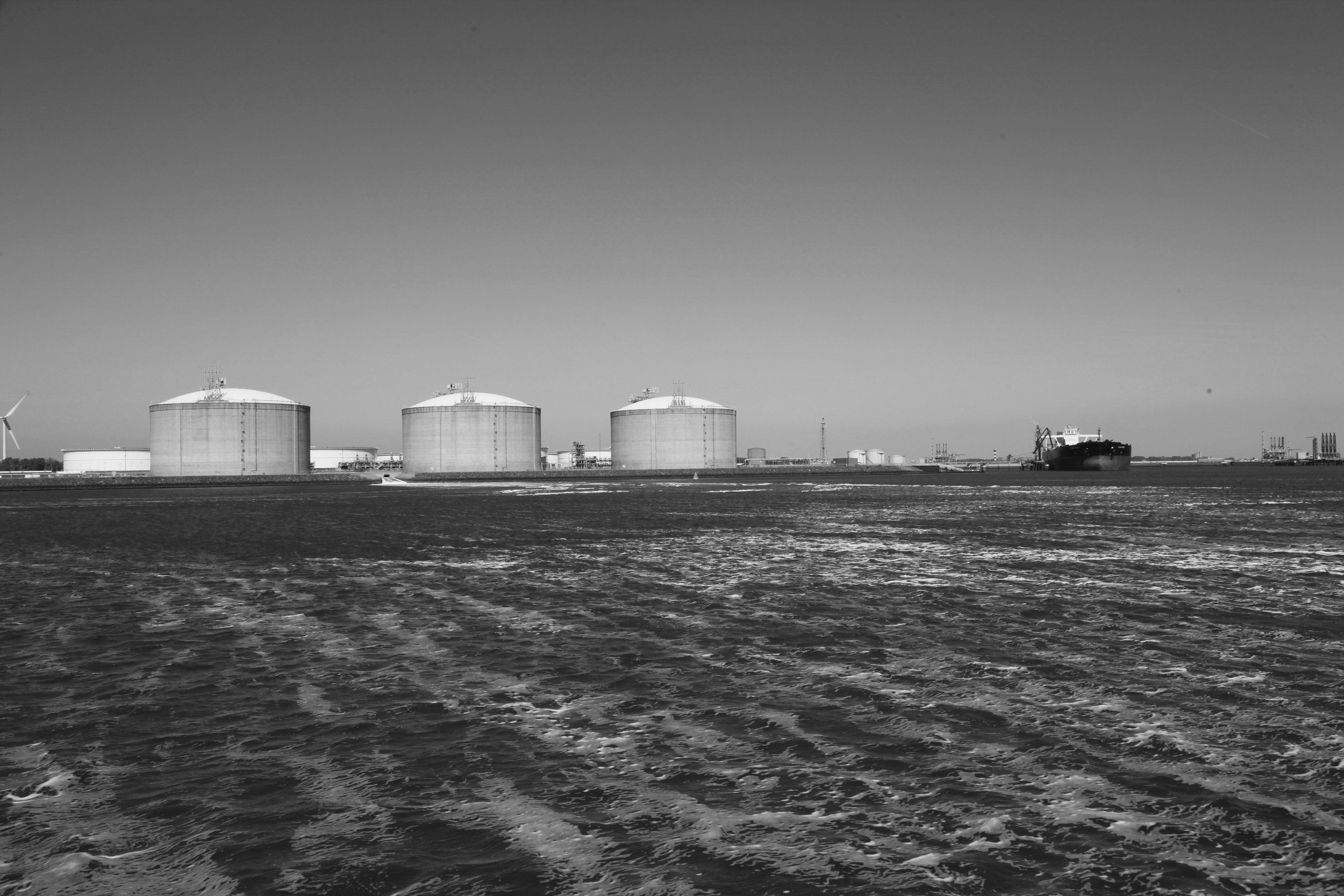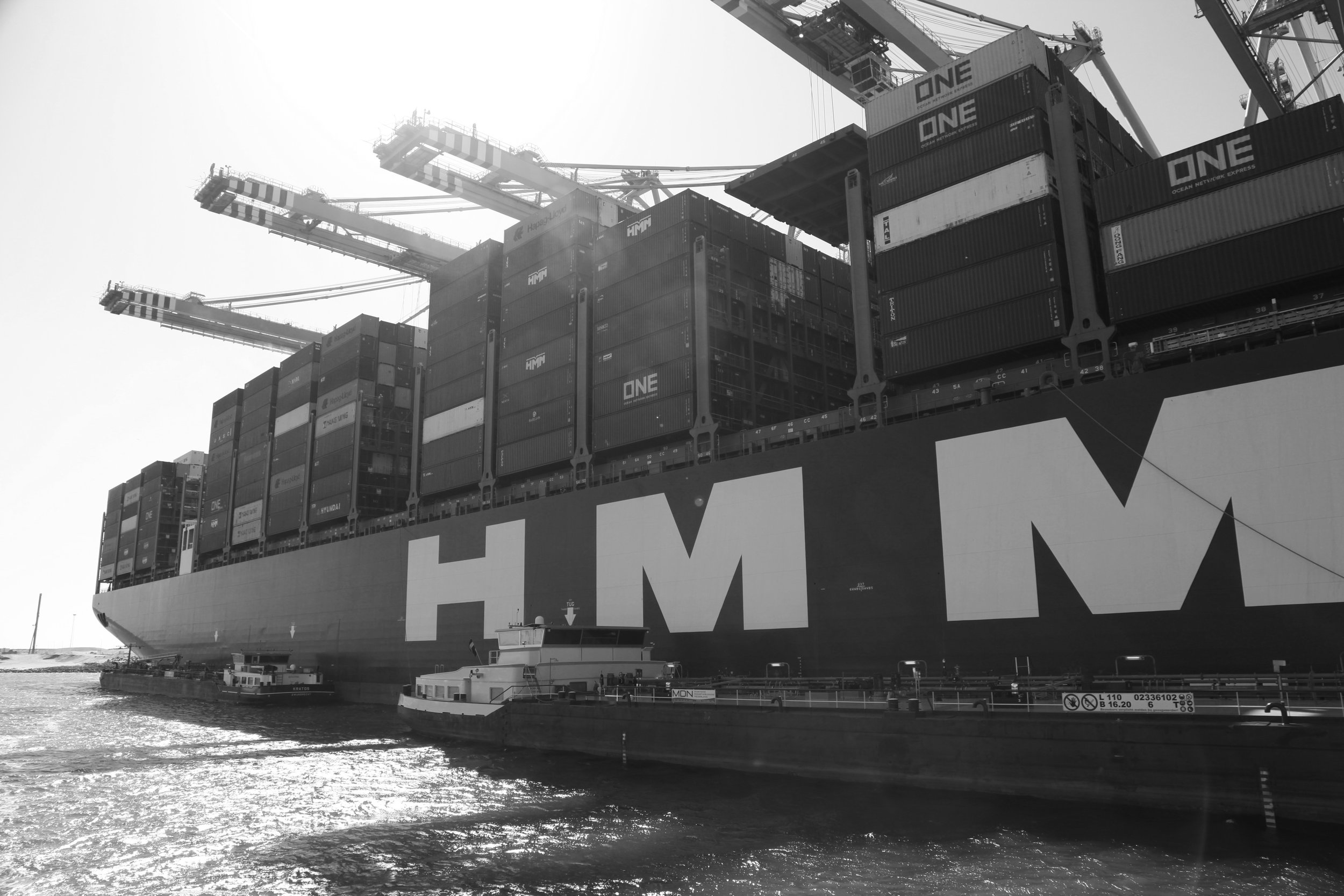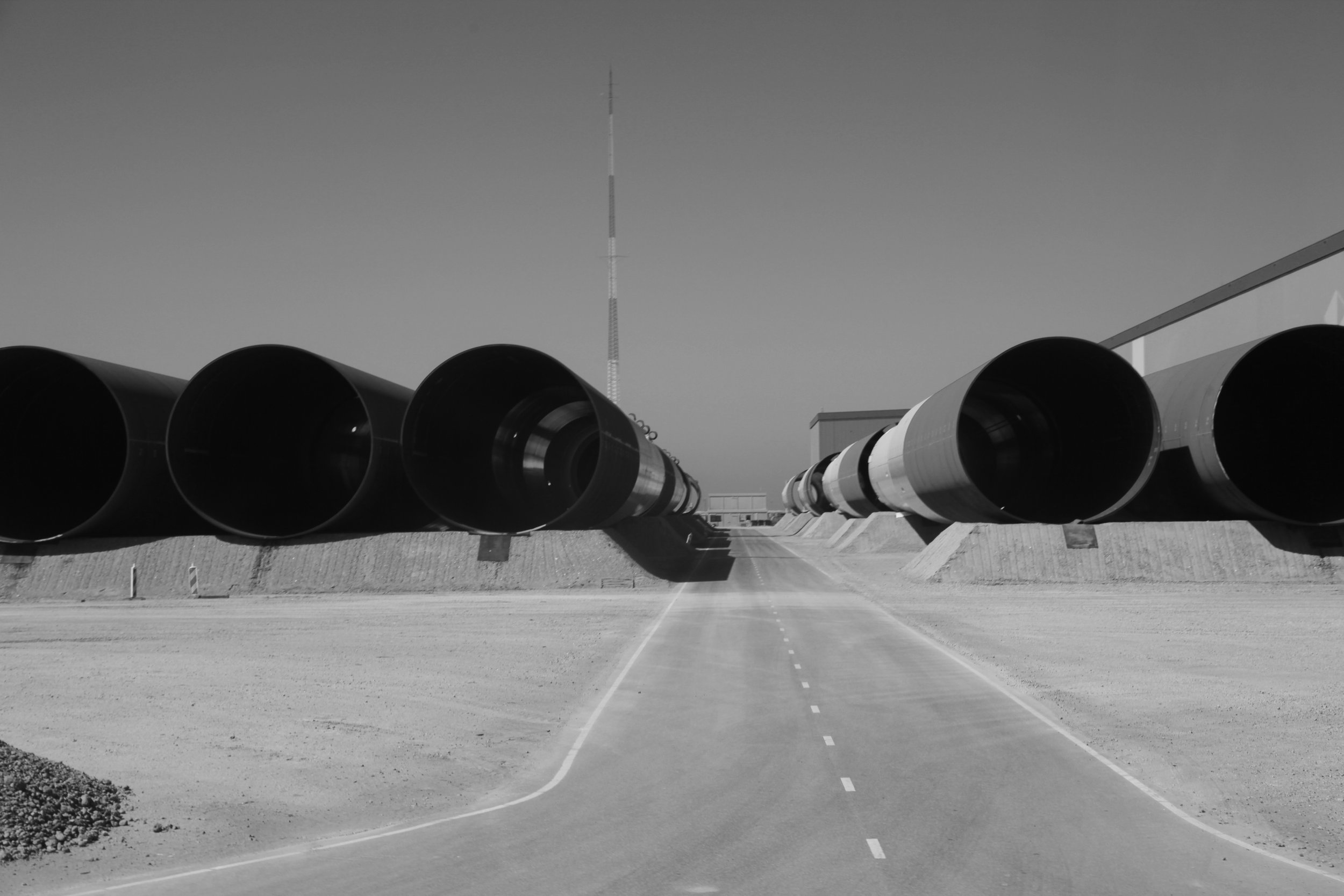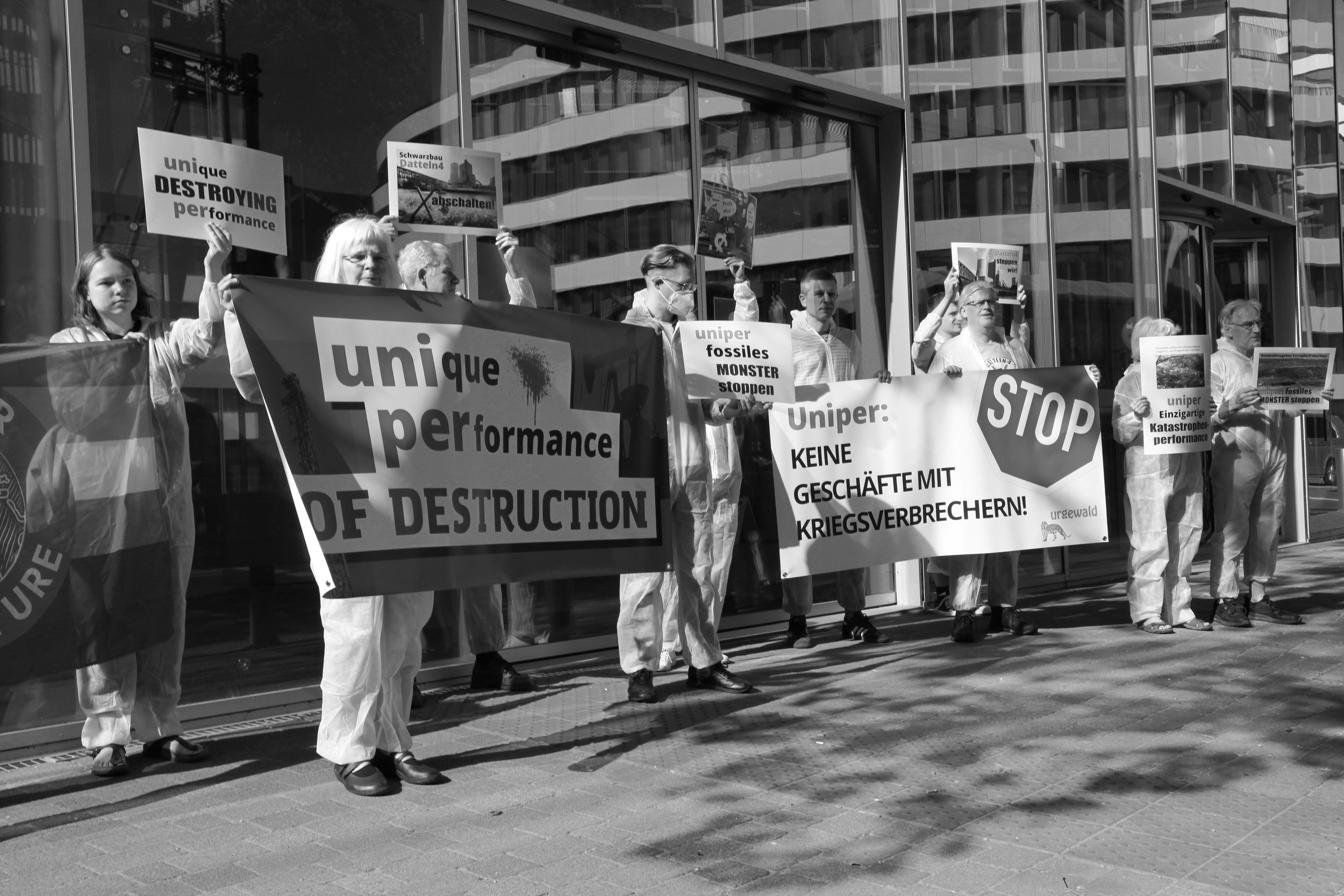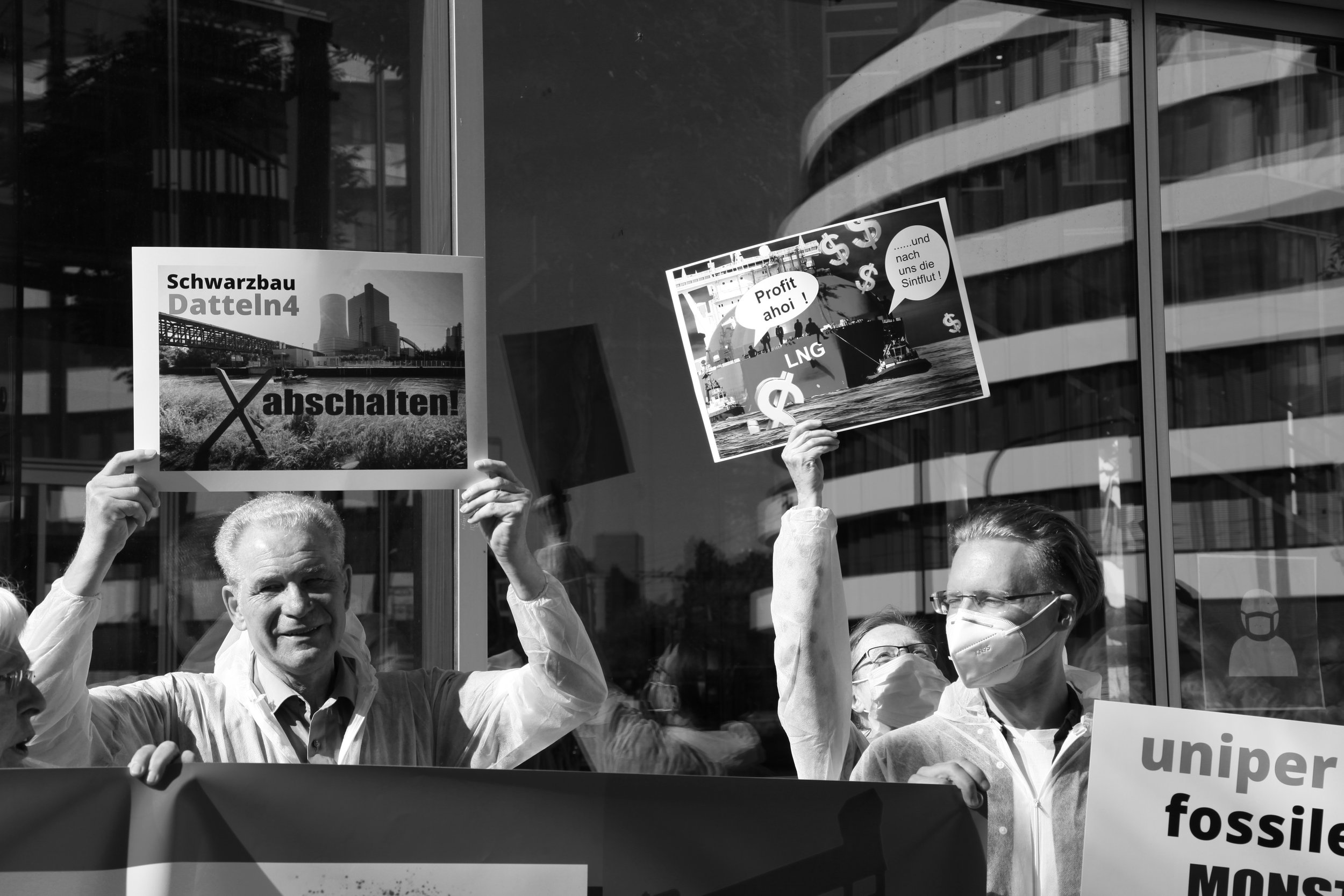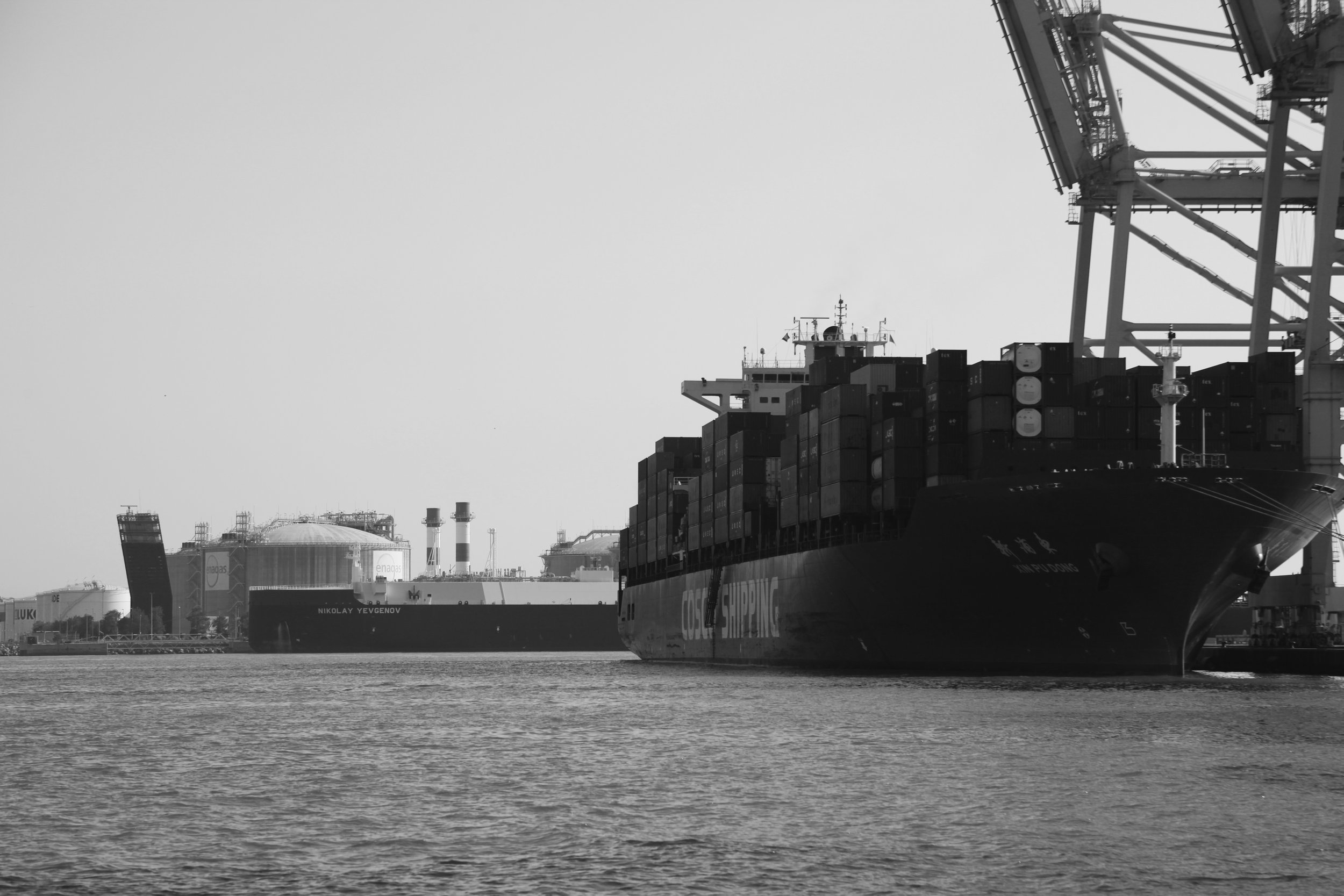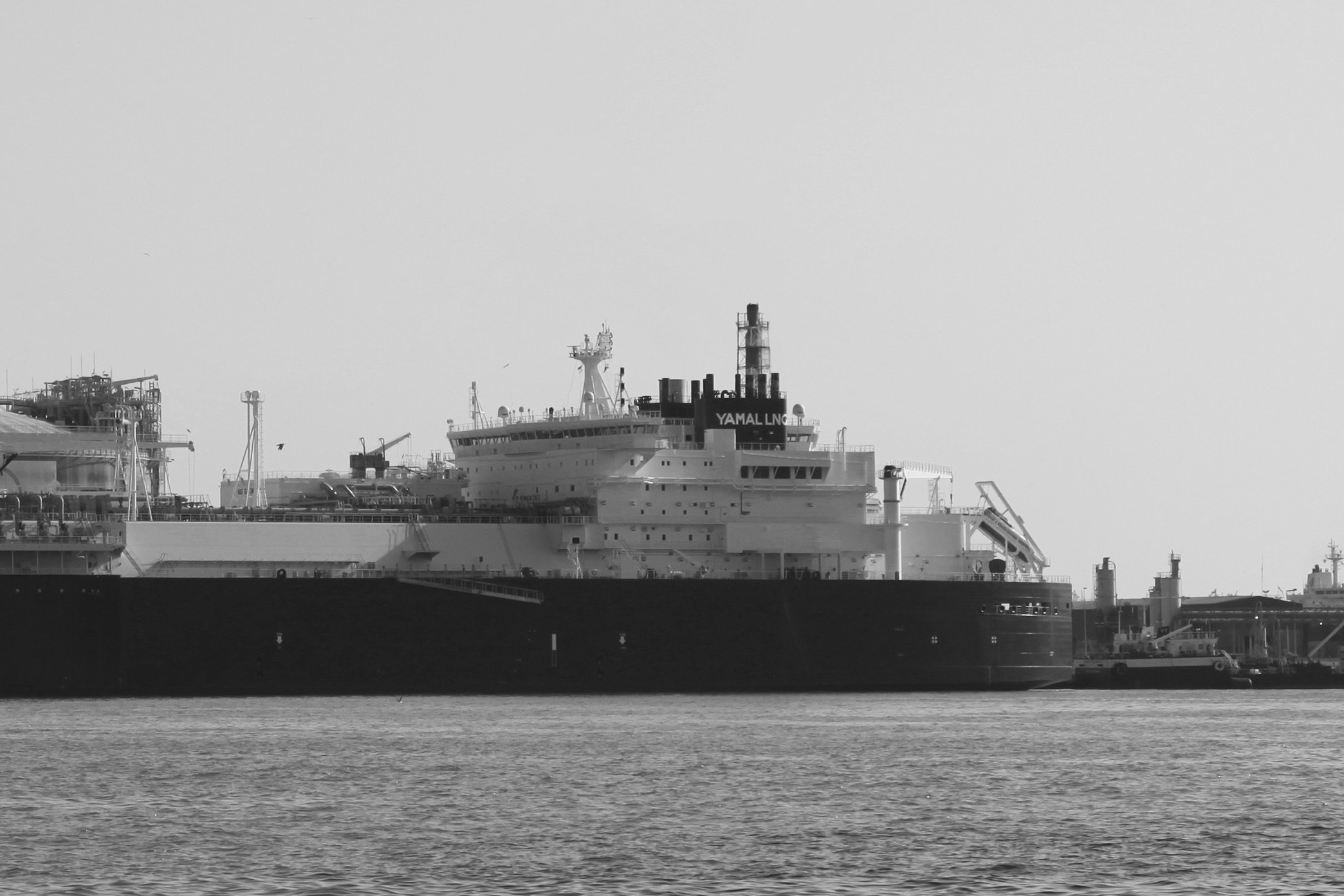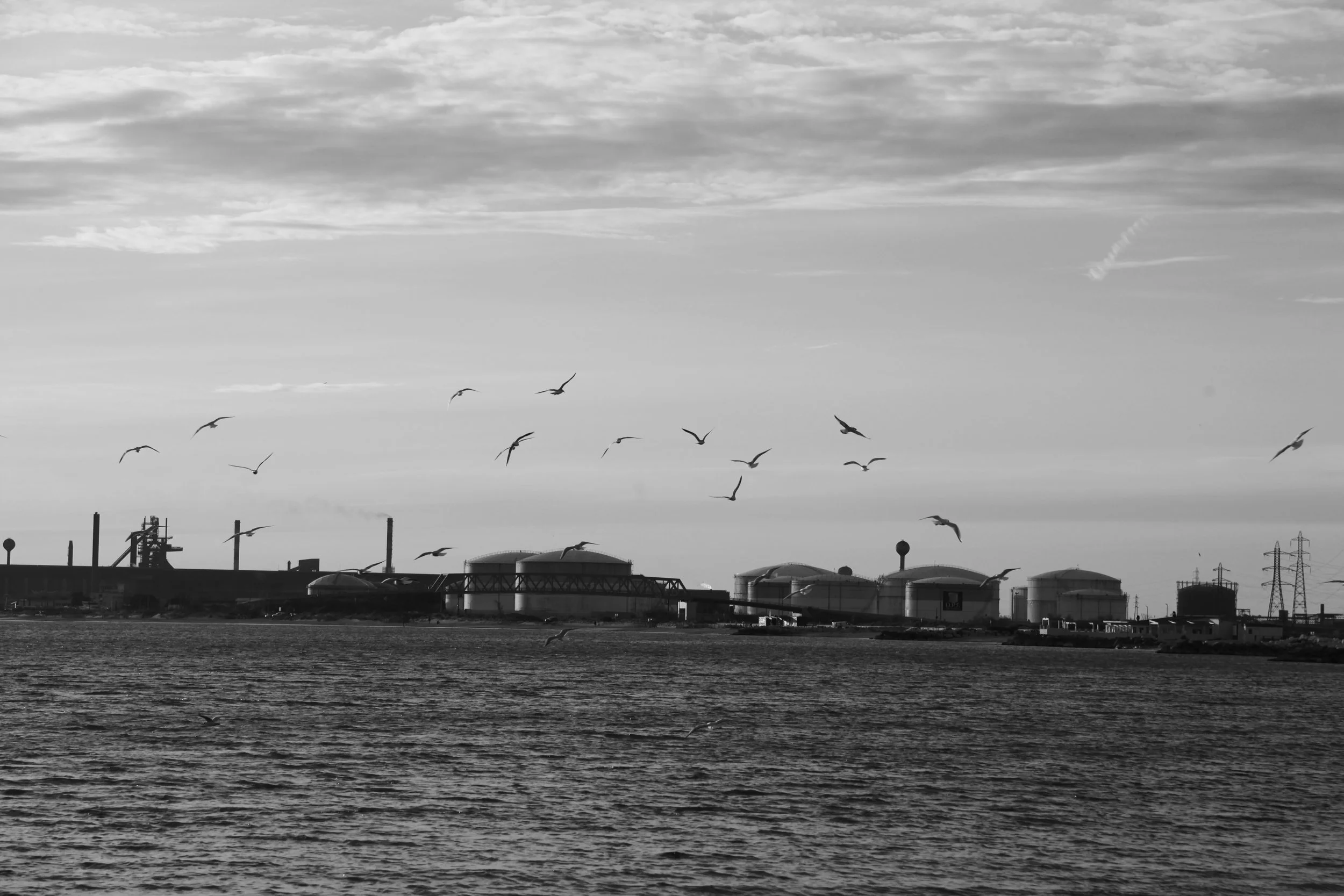IV. Open Season
The port complex of Rotterdam Maasvlakte 1 and 2 juts out like a balled fist into the North Sea about 30km west of the city of Rotterdam.
With the developing Maasvlakte 2 billed as “Europe’s most modern port” by the Rotterdam Port Authority, the artificial landscape is the result of a decades-long land reclamation project aimed at extending Europe’s largest port complex at Rotterdam and expanding a key fossil fuel hub. Maasvlakte’s Gate Terminal operates as an import port for LNG and petroleum tankers, notably from Russia and the United States. Coal is also delivered to the terminal directly by ship and burned in two separate power plants: one across from the Gate Terminal is run by the German-based energy firm Uniper, and another owned by American company Riverstone Holdings is located down the road.
The Gate Terminal (above), discharged water from LNG terminal and crude oil tanker Blue Nova arrived for the USA (middle), large container ship (bottom). Rotterdam Maasvlakte, Netherlands, May 1, 2022
The Gate Terminal is a key part of the Netherlands’ role as a major fossil fuel consumer and distributor in Europe. Although known for its economic innovation and high quality of life, the Dutch economy is also one of Europe’s most polluting countries in relation to its size. The Netherlands ranked in 6th place out of 27 EU member states for greenhouse gas emissions per capita in 2020 according to the most recent European Commission data. The country also notably has one of the largest shares of natural gas in its energy mix within Europe. Although investment in natural gas as a “bridge fuel” is continued to be touted by the fossil fuel industry and leading European politicians, the case of the Netherlands demonstrates that greenhouse gas emissions can remain high in a natural gas-heavy economy with high energy consumption. In the coming decade, the Dutch government will first focus on improving their currently low share of renewable power through offshore wind projects and trying to phase out the remainder of the country’s coal consumption for electricity.
Reclaimed shoreline (above) and offshore wind turbine foundations manufacturing facility run by Sif (bottom). Rotterdam Maasvlakte, Netherlands, May 1, 2022
As a major fossil fuel market, the Netherlands is one of Russia’s leading trading partners and was recently the most directly linked economy with Russia within the EU. The 3rd largest destination of Russian exports worldwide in 2020 at approximately 20.0 billion euros, Dutch import value from Russia was only surpassed by China and the United Kingdom. In comparison to neighboring Germany, the Dutch economy directly imported over seven times more per capita from Russia in 2020. A great share of this trade comes from crude oil which is refined and reexported, including to the German market.
According to the Rotterdam Port Authority’s statement on May 23:
“The war in Ukraine has prompted the European Union and other bodies to impose a number of sanctions on Russia. The extensive import of energy (crude oil, oil products, LNG, coal) is not (yet) affected by sanctions, but the export and transshipment of containers in particular suffers from the uncertainty caused by the war and the sanctions.”
Despite an announced embargo of Russian-flagged ships in EU ports on April 8, 2022 by the European Commission, the widely crafted list of exceptions include agricultural imports, metals and many energy products. Adding to the ineffectiveness of the ban is the fact that many Russian LNG, petroleum and chemical tankers fly under different international flags, as is custom in the global seaborne energy trade.
The crude oil tanker Purovsky which arrived from the Russian port of Ust-Luga (above) and Russian-flagged general cargo ship Rusich-6 from St.-Petersburg. Rotterdam Maasvlakte, Netherlands, May 1, 2022
Indeed, it was largely the Russian government which dictated the continued reduction of natural gas flows to Europe in the spring of 2022, as European imports maintained maximal flows on the Nord Stream 1 and Turkstream pipelines through May, as well as actually increasing the number of Russian LNG tankers arriving in EU ports. Gazprom’s demand to importing companies to switch payments from euros to rubles were the stated grounds for gas delivery shutoffs in Poland and Bulgaria on April 27, 2022. Immediately following the shut-off, major European power providers including Uniper switched their payment schemes to rubles via the Gazprombank, by making an initial payment in euros is which then converted to the rubles. Presumably it is the companies which pay the exchange rate, effectively complying to Gazprom’s demands.
The Uniper Power Station, Rotterdam Maasvlakte, Netherlands, May 1, 2022
On May 21, Finland became the latest country to have gas supplies shut off from Russia after Finnish state-owned company Gasum failed to adopt the new payment scheme. Ironically, energy company Uniper is controlled by Finland’s highest revenue producing company Fortum, also majority-owned by the Finnish government. A few days prior, a small group of activists were outside of Uniper headquarters in Düsseldorf, Germany to protest the company’s continued business with Gazprom as well as continued fossil fuel investments including for LNG and coal. Due to the EU embargo on Russian coal announced in March, the European market will source additional supplies from other producers including Colombia, where the El Cerrejón open-cast coal mine is a center for human rights violations. About 30km from Düsseldorf, power company RWE plans to raze the village of Lützerath for an expansion of their own open-cast brown coal mine Garzweiler, one of the largest in Europe.
Protest outside Uniper Headquarters, Düsseldorf, Germany, May 18, 2022
As the Uniper coal power station continues operations in the Maasvlakte, the Netherlands is struggling to deal with the energy crisis despite its history as a major natural gas producer. In the month of March 2022, energy price-driven inflation increased by over 4% alone, and 10% over the previous twelve year-period. Domestic production has declined in recent years notably at the Groningen Gas Field where decades-long environmental damage, including from persistent earthquakes from gas drilling, has forced companies Royal Dutch Shell and Exxon to pay at least 1.2 billion euros to area residents in compensation payments since 2015. At Maasvlakte, the Onyx Power Station owned by American finance company Riverstone Holdings announced that it will continue operations, bypassing its original shut-down date proposed by the Dutch government. As reported in the Dutch daily newspaper de Volkskrant, the Dutch climate and energy minister Rob Jetten is “very disappointed” by the announcement which came despite a 212.5 million euro promised buyout payment offered by the Dutch government for the closure of the plant. Riverstone Holdings has decided it can do better business by keeping the plant open, as coal power enjoys new life in the strained energy market of skyrocketing electricity prices.
Smokestack from the Onyx Power Station, Rotterdam Maasvlakte, May 1, 2022
The Netherlands’ recent struggles with natural gas prices and stagnating emissions reductions have not prevented the government of neighboring Germany from committing to one of the largest fossil fuel import infrastructure projects in the country’s history. A 50% co-financing scheme by German state bank KfW is now proposed for the German LNG terminal project at Brunsbüttel, greatly motivating bidding investors Dutch state-owned Gasunie and German energy company RWE. This is just one of a growing list of proposed LNG terminals in Germany, some which have been newly endorsed by the German government.
Unlike all other large EU countries, Germany has no LNG import terminal. As Europe’s largest natural gas consumer, it continues to rely on pipeline delivers directly from Russia via Nord Stream 1, as well as Norwegian, Dutch and Belgian distribution networks. The Yamal-Europe pipeline, another major source of Russian natural gas, was completely shut off by Gazprom in May. While countries such as Spain and France have had LNG import terminals for decades, German projects have failed to reach the construction phase due to a combination of environmentalist opposition and insufficient private investment.
At 11:26 at night on Thursday, May 19th. 2022, while much of the Germany was already sleeping, the 39-page LNG Fast-track Bill was voted on by the Bundestag. The bill was passed unanimously by the ruling coalition of SPD, die Grüne and FDP as well as by opposition faction CDU/CDU, with abstention for opposition parties Die Linke and AfD. The newly minted legislation declares:
“With Russia's war of aggression against Ukraine, which began on February 24, 2022, the energy and security policy assessment of dependence on Russian gas supplies has changed at short notice and fundamentally in an unforseen manner,” adding that, “Due to the current exceptional situation, which requires a fast and reliable security of energy supply by LNG, the approval authorities are enabled to temporarily waive certain procedural requirements, in particular in the area of environmental impact assessment, under clearly defined conditions.“
Although many pages are dedicated to the importance of bypassing normal procedure for environmental impact assessments and standard competitive bidding rules, there is a perfunctory one-word answer under the section “alternatives”: keine (none).
Proposed site for the “German LNG” terminal with shuttered nuclear power plant in the distance, Brunsbüttel, May 15, 2022
Andy Gheorghiu, one of Germany’s leading anti-fracking campaigners and consultants, strongly disagrees with the proposed terminals which he believes would “torpedo Germany’s binding commitment of climate neutrality by 2045.” He began his environmental career in 2012 after a Canadian-American company knocked on his door in the region Nordhessen and applied for a fracking license. He soon quit his job at the time to start a new career working full-time to oppose fracking in Germany and internationally. The campaign to block fracking on German soil was successful. Since then Gheorghiu has been involved with organizations opposing fracked import fuels along the transatlantic supply chain, including the Climate Alliance Against LNG since 2018. Gheorghiu explains,
“Uniper scrapped the LNG plans for one of the sites at Wilhelmshaven but then the war started and since then we see just a mad push for LNG terminals….they’re popping up like mushrooms and we are debating now up to 11 LNG terminals for Germany,” says Gheorghiu… “the LNG Fast-track Bill wants to basically do two things. One is to reduce public participation rights. The other thing is to define LNG of being of overriding public interest and this will enable them to really fast-track or actually phase out an environmental impact assessment. Definitely a climate assessment. Which would basically mean that there will be no assessment at all.”
For Gheorghiu, the alternatives are clear,
“First and foremost in times like these, when we see what this strong fossil fuel dependency does, the first priority should be and must be, how do we reduce our gas consumption? The second priority should be how do we increase energy efficiency measures? And the third one would be, how do we increase the production of renewable energy? It shouldn’t be let’s continue business as usual, out of the frying pan into the fire’… If you’re addicted to vodka and you want to get sober, you don’t switch to whisky to get rid of your addition, right? You need to go sober, straight.”
Gheorghiu advocates the implementation of regional task forces to identify energy waste, as well as finding out how much industrial companies actually use. While he personally does not think increasing LNG imports is wise, he cites studies which show that Germany could replace short-term natural gas demand with existing LNG import terminals in the Netherlands and Belgium, negating the need for building new, large natural fossil gas infrastructure.
Interview with subtitles below (click on CC)
New onshore terminals such as in Brunsbüttel wouldn’t come online until 2026, and could continue operating until 2043 according to the new law. While, power company RWE claims that they would eventually convert the Brunsbüttel terminal into an import point for green hydrogen, no technical study or plan has been published. Bengt Bergt, SPD (Schleswig-Holstein), in broadcasted comments before the LNG Fast-track Bill vote on May 19 acknowledges that, “LNG is not the greatest energy source: the cooling is expensive, the transport routes long and it’s not climate friendly either…“ but that, “We have it in our hands that the terminal will already be built hydrogen-ready, thus enabling an earlier switch to climate neutral gases.” Andy Gheorghiu calls the plan “technically unfeasible” with a maximum of 20% hydrogen eventually being able to be mixed into the proposed infrastructure.
On May 25, a week following success of the LNG Fast-Track Bill, German energy company RWE announced a deal with Sempra Industries to import fracked natural gas from the Port Arthur, Texas terminal currently under construction. In the their press release, RWE states,
“The terms contemplate negotiations and finalization of a definitive 15-year supply and purchase contract for approximately 2.25 million tonnes per year of LNG. The volumes will be delivered at the U.S. coast and can be shipped by RWE to any location in the world- as an example to the planned LNG import facilities in Germany.”
And while economic minister Robert Habeck made a public visit to Qatar in March to solicit alternative natural gas supplies, a recent article in from The Middle East Eye shows that the “Qatari gas” would in fact come from a Qatar-owned subsidiary company Texas where supplies are sourced from fracking. Since no environmental conditions concerning LNG nor a climate assessment exist in the current law, importing companies will be free to choose the pace and origin or their cargo. If the German government decides to back out of LNG imports before 2043 under the current structure, investing companies could sue also for lost profits from shuttered terminals according to Gheorghiu.
Brunsbüttel, May 15, 2022
On June 3, the EU announced an overarching embargo on Russian oil imports effective by the end of 2022. Exceptions would include pipeline oil to certain member states, but would cover approximately 90% of all Russian imports including all tanker deliveries by sea. The European Commission’s press release states, “The ban is subject to certain transition periods to allow the sector and global markets to adapt, and a temporary exemption for pipeline crude oil to ensure that Russian oil is phased out in an orderly fashion. This will allow the EU and its partners to secure alternative supplies and minimises the impact on global oil prices.”
During the spring, Russia rapidly adapted their export oil and natural gas export strategy while maintaining business with the European market where it remained most profitable. The Wall Street Journal reports that Russia has rerouted shipments to the Indian importers, not only to feed the energy demands of the world’s second most populous country, but to be refined for reshipment to the United States and Europe. Russian petroleum is currently selling at a cut rate on the world market, but skyrocketing oil prices have still led to a net gain in revenues. The Centre for Research on Energy and Clean Air (CREA), a nonprofit think tank based in Helsinki, shows that “Russia’s average export prices were an average 60% higher than last year, even if they were discounted from international prices.”
Russian fossil fuels revenues totalled 93 billion euros during the first 100 days of the invasion of Ukraine, in which the EU contributed approximately 57 billion euros (61% of the global total). Germany led the EU with overall payments of approximately 12.1 billion euros, followed by Italy and the Netherlands at 7.8 billion euros each. Overall EU energy imports from Russia reached a modest 16% reduction of volumes wit the above the importers all below this mark. A group of countries significantly reduced imports including Sweden (99%), Lithuania (78%), Spain (56%), Finland (56%), Poland (51%) and Estonia (51%). This did not exclude certain EU importers from profiting from the situation well beyond the first two weeks of the Russian invasion in EU which natural gas imports “increased to the highest volume observed this year”.
During the period of April and May, the CREA report states:
“European buyers in France, Belgium in the Netherlands, bought most of the short-term cargoes at a discount, buying LNG and crude oil on the spot market. These purchases take place outside of pre-existing contracts, therefore representing an active purchase decision.”
France had the most of such purchases for a total 899 million euros. They joined China, India, the United Arab Emirates and Saudi Arabia in increasing total import volumes from Russia during the spring, according to CREA. As if to prove that the total of over 4 billion euros paid to the Russian government since February is strictly business, France became the global leader of LNG imports of US fracked gas in March and April 2022, according to the most recent reports from United States Department of Energy.
The Nikolay Yevgenov from Sabetta, Russia ventured into Mediterranean waters to discharge its cargo of LNG. Barcelona, June 4, 2022.
The Russian invasion of Ukraine passed its hundredth day on June 3, with no peaceful end in sight. The EU’s calibrated sanctions regime and delayed response to Russian energy imports appears to have done little or nothing to dissuade Vladimir Putin and Moscow’s leadership from continuing the war. While Ukrainian grain shipments remain trapped in the Black Sea, putting millions at risk for hunger globally, Russian-chartered tankers continue to deliver to European ports. The announcement of Ukraine and Moldova’s candidate status to join the EU on Friday, June 24 coincided with the evening arrival of the crude oil tanker Nordic Josephine in Barcelona. Marked as a “for orders” (short-term) contract by maritime analytics site MarineTraffic, it arrived from Novorossiysk, Russia’s largest Black Sea port. Unlike the publicly heralded departure of Russian oligarch Roman Abromovich’s yacht from Barcelona in March, this lucrative arrival remained anonymous outside of the marine shipping world. As the tourism season starts in full swing in the Catalan capital and along the Mediterranean coast, many of Europe’s energy companies are seeking out advantageous natural gas and oil deals, without making too much of a fuss about where the product is coming from.
A cruise ship passes the Nordic Josephine in Barcelona, June 24, 2022.

